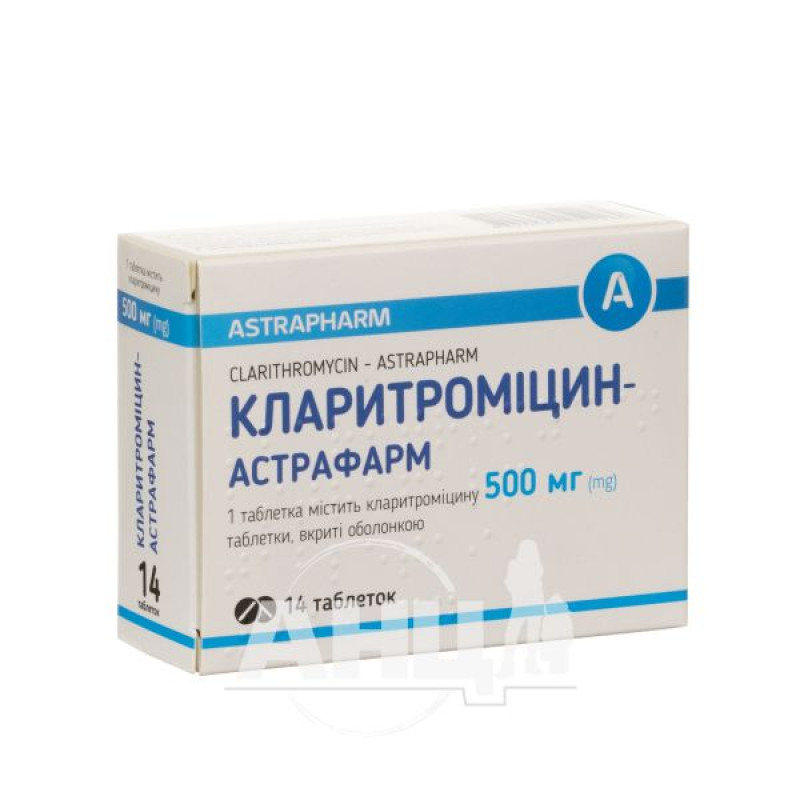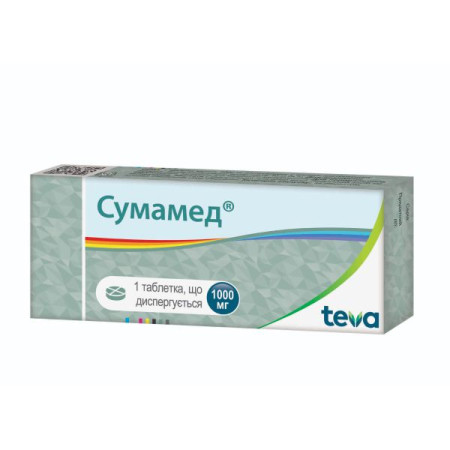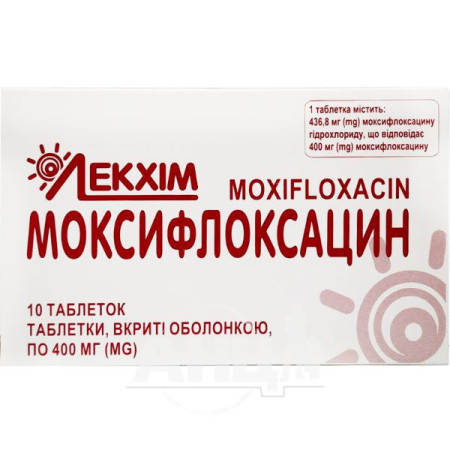Clarithromycin-Zdorovye film-coated tablets 500 mg blister No. 14

"Clarithromycin-Health" tablets are used for the following indications:
Upper respiratory tract infections, i.e. nasopharynx (tonsillitis, pharyngitis), and paranasal sinus infections. Lower respiratory tract infections (bronchitis, acute croupous pneumonia and primary atypical pneumonia). Skin and soft tissue infections (impetigo, folliculitis, erysipeloid, furunculosis, infected wounds). Acute and chronic odontogenic infections. Disseminated or localized mycobacterial infections caused by Mycobacterium avium or Mycobacterium intracellulare. Localized infections caused by Mycobacterium chelonae, Mycobacterium fortuitum or Mycobacterium kansasii. Eradication of H. pylori in patients with duodenal ulcer when suppressing hydrochloric acid secretion (clarithromycin has greater activity against H. pylori at neutral pH than at acidic pH).Composition
Active ingredient: clarithromycin.
1 tablet contains 250 mg or 500 mg of clarithromycin.
Excipients: pregelatinized starch, corn starch, magnesium stearate, colloidal anhydrous silica, talc, microcrystalline cellulose, croscarmellose sodium, sodium lauryl sulfate, hypromellose, titanium dioxide (E 171); dye: sunset yellow FCF (E 110) (dosage 250 mg) or tartrazine (E 102) (dosage 500 mg).
Contraindication
Hypersensitivity to macrolide antibiotics or to any of the excipients. Concomitant use of clarithromycin and any of the following: astemizole, cisapride, pimozide, terfenadine (as this may lead to QT prolongation and cardiac arrhythmias including ventricular tachycardia, ventricular fibrillation and torsades de pointes), ergot alkaloids such as ergotamine, dihydroergotamine (as this may lead to ergotoxicity), HMG-CoA reductase inhibitors (statins) extensively metabolised by CYP3A4 (lovastatin or simvastatin) due to increased risk of myopathy including rhabdomyolysis.Method of application
The recommended dose of clarithromycin for adults and children aged 12 years and over is 250 mg every 12 hours, with more severe infections the dose may be increased to 500 mg every 12 hours. The usual duration of treatment depends on the severity of the infection and is 6 to 14 days.
The drug can be used regardless of food intake, since food does not affect the bioavailability of clarithromycin.
Features
Pregnant women
The safety of clarithromycin during pregnancy or breastfeeding has not been established.
Children
Children under 12 years of age should use clarithromycin suspension, as the use of clarithromycin tablets in children of this age has not been studied.
Drivers
No data on exposure are available.
Overdose
Symptoms: There have been reports that clarithromycin overdose may cause gastrointestinal symptoms. One patient with a history of bipolar psychosis who took 8 grams of clarithromycin developed altered mental status, paranoid behavior, hypokalemia, and hypoxemia.
Treatment: Adverse reactions associated with overdose should be treated with gastric lavage and symptomatic therapy. As with other macrolides, hemodialysis or peritoneal dialysis is unlikely to significantly affect serum clarithromycin levels.
Side effects
Infections and infestations: uncommon – cellulitis1, candidiasis, gastroenteritis2, infection3, vaginal infection; frequency unknown – pseudomembranous colitis, erysipelas.
Blood and lymphatic system disorders: uncommon – leukopenia, neutropenia4, thrombocythemia3, eosinophilia4; frequency unknown – agranulocytosis, thrombocytopenia.
Immune system disorders: uncommon – anaphylactoid reactions1, hypersensitivity; frequency unknown – anaphylactic reactions, angioedema.
Metabolism and nutrition disorders: uncommon – anorexia, decreased appetite; frequency unknown – hypoglycemia.
Psychiatric disorders: common: insomnia; uncommon: anxiety, nervousness3; frequency unknown: psychosis, confusion, depersonalization, depression, disorientation, hallucinations, nightmares, mania.
CNS: common - dysgeusia (taste disturbance), headache; uncommon - loss of consciousness1, dyskinesia1, dizziness, drowsiness, tremor; frequency unknown - convulsions, ageusia (loss of taste), parosmia, anosmia, paresthesia.
From the side of the organs of hearing and labyrinth: infrequently - vertigo, hearing impairment, tinnitus; frequency unknown - hearing loss.
Cardiac disorders: uncommon – cardiac arrest1, atrial fibrillation1, QT prolongation, extrasystoles1, palpitations; frequency unknown – torsades de pointes, ventricular tachycardia, ventricular fibrillation.
Vascular disorders: common – vasodilation1; frequency unknown – hemorrhage.
Respiratory, thoracic and mediastinal disorders: uncommon – asthma1, epistaxis2, pulmonary embolism1.
From the digestive system: frequent - diarrhea, vomiting, dyspepsia, nausea, abdominal pain; infrequent - esophagitis1, gastroesophageal reflux disease2, gastritis, proctalgia2, stomatitis, glossitis, abdominal distension4, constipation, dry mouth, eructation, flatulence; frequency unknown - acute pancreatitis, tongue discoloration, tooth discoloration.
Skin and subcutaneous tissue disorders: common: rash, hyperhidrosis; uncommon: bullous dermatitis1, pruritus, urticaria, maculopapular rash3; frequency unknown: severe cutaneous adverse reactions (e.g. acute generalized exanthematous pustulosis, Stevens-Johnson syndrome, toxic epidermal necrolysis, drug reaction with eosinophilia and systemic symptoms (DRESS)), acne, Henoch-Schonlein disease.
Musculoskeletal and connective tissue disorders: uncommon – muscle spasms3, musculoskeletal rigidity1, myalgia2; frequency unknown – rhabdomyolysis2**, myopathy.
Renal and urinary disorders: uncommon – increased blood creatinine1, increased blood urea1; frequency unknown – renal failure, interstitial nephritis.
General disorders: uncommon – malaise4, fever3, asthenia, chest pain4, chills4, fatigue4.
Laboratory tests: uncommon – albumin-globulin ratio change1, blood alkaline phosphatase increase4, blood lactate dehydrogenase increase4; frequency unknown – MHC increase, prothrombin time increase, urine discoloration.
* Because these reactions are reported voluntarily and the patient population is not known, it is not always possible to establish their frequency or a causal relationship to drug exposure. The total experience with clarithromycin is more than 1 billion patient-days.
** In some reports of rhabdomyolysis, clarithromycin was administered concomitantly with other drugs known to be associated with rhabdomyolysis (such as statins, fibrates, colchicine, or allopurinol).
1,2,3,4These adverse reactions have only been reported with the following formulations: 1 – lyophilized powder for solution for infusion, 2 – prolonged-release tablets, 3 – suspension, 4 – immediate-release tablets.
Interaction
Clarithromycin does not interact with oral contraceptives.
Storage conditions
Store in original packaging at a temperature not exceeding 25°C. Keep out of the reach of children.
Shelf life: 3 years.
There are no reviews for this product.
There are no reviews for this product, be the first to leave your review.
No questions about this product, be the first and ask your question.


